Harishbhai (Harish) Patel – ABS

Title 30 CFR 250 Paragraph Classification by Subpart
Highlights:
This research presented a novel data-driven methodology for evaluating the effectiveness of Bureau of Safety and Environmental Enforcement (BSEE) regulations in Title 30, Code of Federal Regulations, Part 250, which governs offshore oil, gas, and sulfur operations in the U.S. Outer Continental Shelf.
The study developed a comprehensive framework that assesses regulatory effectiveness through two primary dimensions: relevance to current operational conditions and measurable benefits in risk reduction. The framework integrates three distinct categories of datasets: regulation, offshore activity, and developed datasets to enable systematic analysis across multiple dimensions of offshore safety regulation. By treating individual regulatory paragraphs as fundamental units of analysis, the methodology accommodates the broad scale and diverse subject matter of offshore safety regulations while maintaining analytical consistency. The approach employs artificial intelligence to establish missing relationships between incident data and regulatory citations, complemented by normalized scoring and dense ranking systems for comparative analysis.
Thanks to funding from OESI, the project team was able to deliver this methodology that serves as a screening tool to guide more focused regulatory review efforts, establishing a foundation for evidence-based regulatory assessment in offshore safety management.
Acknowledgements:
- ABS Group: Benjamin Roberts, Garrett Devol, Masood Kahn, Barrett Ray, Jessica Huber, Emily Weeden, Matthew Hubbard, Nathaniel Smith, Emily Constantin, Ryan Kettle, Deepti Vikram, Patrick Craig, John Blackaby, and Nathan Lee
- ABS: Harish Patel, Lauren Sparks
- Jim Pettigrew
- JA Watson IV LLC: Jim Watson
- WJP Enterprises: Wanda J. Parker
MooHyun Kim – TEES

Free surface snapshot in extreme storm and flow field snapshot in tsunami by high-fidelity CFD digital twin

Earthquake/seaquake simulation by mid-fidelity digital twins
Highlights:
In this project, the team developed reliable mid-fidelity and high-fidelity FOWT DTs (digital twins) for global turbine-floater-mooring fully-coupled dynamics and related safety against various environmental loadings including extreme wind/wave/current and earthquake/seaquake/tsunami. In particular, the capability of simulation for earthquake/seaquake/tsunami is novel and not available in current wind industry and both CFD and mid-fidelity programs were successfully developed. The produced results using the respective-fidelity DTs were found to be reliable through cross-checking and comparisons against experimental data. ABS utilized the simulation results for the respective cases and developed a draft of revised design recommendations for wind industry.
Acknowledgements:
TAMU and TECHNIP-EN team worked hard and successfully developed all the proposed computer simulation programs and ABS used the produced results to draft a sample design recommendation. Equinor and Invenergy provided valuable inputs/opinions for this project as industry advisor.
Onder Akinci – SGH

Highlights:
With a goal of developing an approach and providing guidance for assessing the integrity of offshore steel grating, SGH proposed an inspection technique that applies structural identification and damage detection methods. OESI funded the research that allowed us to evaluate the approach by conducting testing on steel grating samples, including accelerated seawater exposure in a corrosion chamber, material strength testing, vibration testing to assess the effect of damage on the sample; verifying test results with finite element analyses; and estimating the remaining service life of the samples based on corrosion damage. OESI’s support also allowed us to engage external subject matter experts and get feedback from industry stakeholders.
OESI was instrumental in the success of this project from initiating the research to providing feedback throughout the work. This method, when implemented by offshore operators, can potentially replace or accompany current practices used for grating inspections. We believe our proposed method can improve the reliability of steel grating integrity assessment practices, raising the confidence of offshore personnel and inspectors, and contributing to safer offshore facilities.
Acknowledgements:
- SGH: Onder Akinci, Rob MacNeill, Ioannis Kalpakidis, Steven Palkovic, Asa Bassam, Nicholas Catella, Kareem Eltouny, Steven DelloRusso, Keng-Wit Lim, Shivani Gandage, Michael Hughes, Alan Humphreys, Anass Harmal, Jaycee Medina-Flippo
- Arena Offshore: Tahanie Thibodeaux, Johnathon Brown
- Hilti: Jerry Vasylyk, Christopher Gill, Hazem Elsheikh
- DEFL Offshore: Troy McGinty
Andrew Kilner – AMOG

Highlights:
The emerging marine energy industry faces a range of challenges to develop safe and efficient systems. The offshore Oil & Gas (O&G) industry has an extensive catalogue of standards, with the potential to provide a solid foundation for the development of best practices specific to marine energy.
With the support of the Ocean Energy Safety Institute (OESI), AMOG led a project team focused on understanding existing Marine Energy Technology (MET) knowledge, starting with a gap analysis between current MET and O&G best practices. The goal of the study was to evaluate which well-defined existing practices could be adapted for use in the marine energy industry, and to what extent.
The research conducted was compiled into a final comprehensive report, providing a reference for marine energy industry members, at all stages, to consult for supplemental design information. It is one of the industry’s first documents to assemble and present available guidance for developers to review and apply in the transportation, commissioning, operation, and maintenance of new devices. It is also one of the industry’s first reports documenting clear gaps in the existing guidance that require further considerations by developers to ensure safe and efficient system creation.
The Ocean Energy Safety Institute enabled the project to take place through funding the teams research efforts. Their reviews and feedback throughout the project life cycle helped shape the final report to enable technology transition, and allow the document to be a go-to-reference for all experience levels of marine energy industry players.
Acknowledgements:
AMOG would like to acknowledge their project partners ABS and Technip Energies who helped undertake the project work.
AMOG would also like to acknowledge all Marine Energy stakeholders who connected with the Project Team to provide their valuable feedback and experience on the current state of industry knowledge, AJG Risk Management Services, DeepMar Consulting, DoE, Hydrokinetic Energy Corp., Laminar Scientific, Ocean Energy Systems Ltd., Orbital Marine Power, PacWave.
Shiren Wang – Texas A&M Engineering Experiment Station

Highlights:
Our project develops sustainable geopolymer composite materials to design and build eco-friendly offshore grating structures—the walkways and platforms used on ocean-based facilities like wind farms or oil rigs. Traditional materials, such as steel, have high carbon footprints and often corrode in harsh marine environments. In contrast, geopolymers are made from industrial byproducts or natural minerals, and they require far less energy to produce, making them an alternative to conventional construction materials. As-created a material is durable, corrosion-resistant, and strong enough to withstand the demanding conditions at sea. Our grating structure designs take advantage of this material’s light weight and adaptability, while also prioritizing ease of manufacturing and long-term environmental resilience. This innovation can reduce maintenance costs, extend the service life of offshore infrastructure, and significantly cut down on greenhouse gas emissions. Our goal is to offer a greener and more sustainable solution for future marine construction with enhanced safety in the offshore operations. Ultimately, we envision this technology playing a pivotal role in enhancing offshore safety and advancing sustainable marine infrastructure.
Jian Tao – Texas A&M University

Visualization Interfaces - Custom 3D models of environments and workers using environmental and anthropometric data.
Highlights:
This project focuses on making offshore wind turbine operations safer by developing advanced digital “metahuman” models. These models simulate real-life working conditions and human movements, helping identify and reduce risks for workers in challenging environments. With support from OESI, we built a user-friendly platform that combines ergonomic simulations and data science to improve safety assessments. OESI funding was crucial, enabling collaboration between Texas A&M and Georgia Tech and accelerating our research. This project stands out for its innovative use of digital twins and biomechanics, setting a new benchmark for safety in renewable energy operations.
Acknowledgements:
- PI: Jian Tao (TAMU)
- Co-PIs: Xudong Zhang (TAMU), Yu Ding (GTech)
- TAMU Graduate Research Assistants: Alyssa Cassity (MS), Ahmadreza Chokhachian (Ph.D.), Britain Thomas (MS), Erik Priest (MS), Hernan Santos, Sina Alidoust Salimi (MS), Yinong Chen (Ph.D.)
- Industrial Advisory Board:
- Shawn Sheng, Senior research engineer, National Renewable Energy Laboratory
- Tom Cassidy, QSHHE Manager, Ocean Winds North America
- Beate Hildenbrand, G+ Head of the Americas, G+ Global Offshore Wind Health and Safety Organization
Kevin McSweeny – American Bureau of Shipping (ABS)
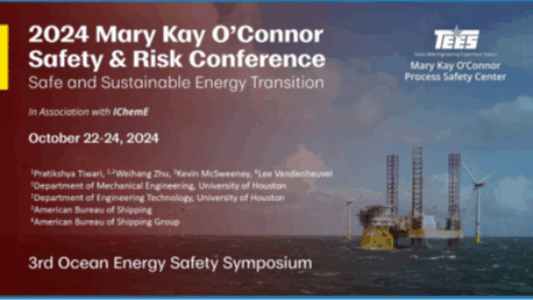
Highlights:
Cranes are essential for offshore work, but they come with safety risks. ABS in partnership with ABS Group, and the University of Houston conducted research exploring why crane accidents happen from the viewpoint of human factors. Detailed reviews of existing literature/publications regarding crane incidents and interactions with industry (e.g., offshore owners, operators, crane personnel), and onshore-based crane industry groups yield insight into the human factors faced by the lifting industry.
OESI played a crucial role in our project’s success. Their funding provided access to industry contacts, valuable data, and essential resources, enabling us to thoroughly investigate human factor-related crane lifting incidents.
Human error is a major cause of crane accidents, with 92.9% of them due to mistakes made by people. This highlights the importance of good communication and teamwork. The project will help the OESI membership and the offshore industry to develop safety strategies or initiatives targeted at preventing incidents and improving safety.
Acknowledgements:
- ABS: Kevin McSweeney, Whitney Mantooth, Lauren Sparks
- ABS Group: Lee Vandenhuevel
- University of Houston: Weihang Zhu, Pratikshya Tiwari
Mario Rotea – University of Texas at Dallas

Highlights:
The main objectives are to identify effective sensors for high-risk components and to develop algorithms that analyze sensor data for signs of failure or damage. With support from OESI 2.0, the team successfully demonstrated real-time damage detection using simple motion sensors. Machine learning algorithms were developed and tested to extract damage information and assess its severity from the sensor data. The team also demonstrated transmission of strain data through a fiber optic emulator, and temperature modeling along power cables.
Acknowledgements:
The team members Mario Rotea (PI), D. Todd Griffith, Jie Zhang, Moohyun Kim, Yangmin Ding and Yue Tain are grateful to the cost share provided by the University of Texas at Dallas, Texas A&M, and NEC Laboratories America.
Moohyun Kim – Texas A&M Engineering Experiment Station
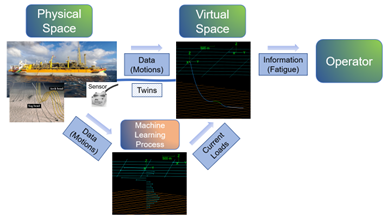
Overview of proposed approach: digital twin plus machine learning for real-time underwater-line monitoring

Digital twin: FPSO with mooring lines and steel lazy-wave risers
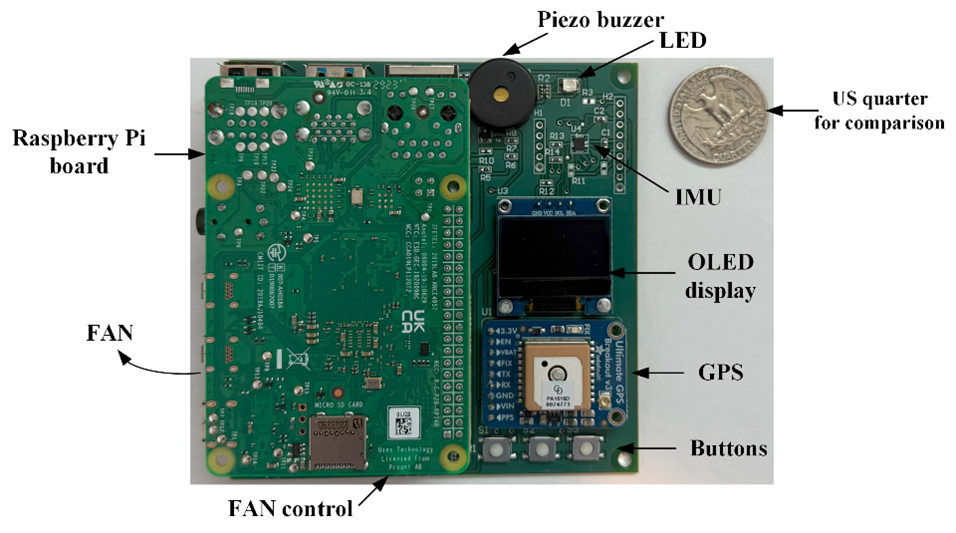
Fabricated physical unit
Highlights:
Acknowledgements:
Prof. Byul Hur (CoPI) contributed to the fabrication of the physical unit. ExxonMobil provided relevant measured current and FPSO data.
Erna Grelle – Argonne National Laboratory
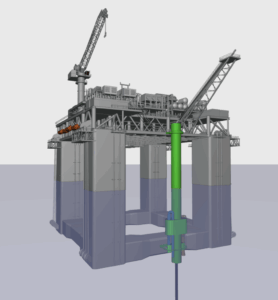
Highlights:
The focus of this project was to evaluate the possibility of using OTEC to power monitoring systems for plugged and abandoned (PA) wells in the Gulf of America. Currently, there is no requirement for monitoring PA wells after their decommissioning is complete, which has raised concerns about potential unabated methane leakage from these wells. At the same time, powering a monitoring system is not trivial since the waters on the Gulf of America are not connected to the power grid, necessitating an alternative approach. This study considered marine energy resources, well locations, and monitoring system power requirements, and aimed to design a monitoring scheme powered by OTEC. Additionally, the study considered possibilities in which OTEC can supply power to offshore oil and gas platforms.
Acknowledgements:
The research team would like to acknowledge the time and helpful feedback of the OESI Joint Steering Committee and project management team members. Additionally, the authors would like to thank the numerous people across companies, universities, government, and fellow national labs for their generous time in providing input on various aspects throughout this study.
Mohsen Ahmadian, Mahdi Haddad – University of Texas – Austin

Engineered defective P&A wells, designed and constructed by Dr. Ahmadian’s team at UT-Austin BEG/AEC’s DGTS, were used to demonstrate their novel EM-SP survey concept at TRL 6.
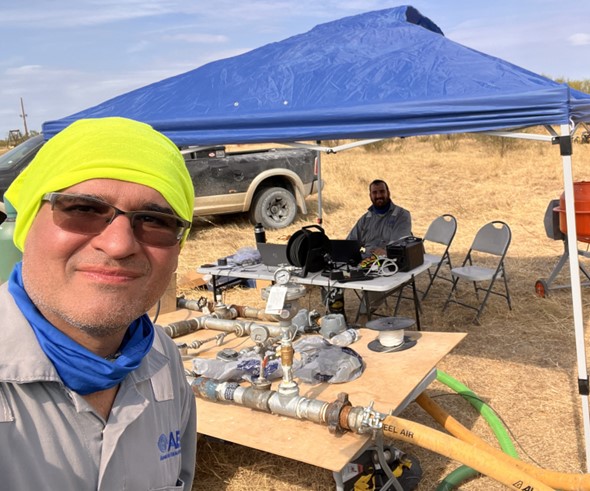
Dr. Mahdi Haddad (co-PI) and Kemal Ozel (Student research scholar) at the data-acquisition and pump station during the final field test.
Highlights:
Great news for our planet! A team of researchers, led by Drs. Mohsen Ahmadian (PI) and Mahdi Haddad (co-PI) at the University of Texas at Austin (UT-Austin), with a $500K OESI grant, including a >20% cost match from the Advanced Energy Consortium (AEC), has developed a novel and noninvasive electromagnetic (EM) survey method to detect hidden leaks from plugged-and-abandoned (P&A) wells.
The P&A wells are meant to be permanently sealed, but sometimes they fail, posing risks to land and water. This team engineered a special approach that uses natural flow-induced electrical signals in the ground and surface sensing to identify when leaks occur! Thanks to OESI and AEC funding, and Dr. Ahmadian’s management of UT-Austin BEG’s Devine Geophysical Test Site (DGTS), the team demonstrated this concept at field scale with a limited budget and in about a year! This involved constructing two engineered defective P&A wells to validate the team’s patent-pending technology under real-world conditions rigorously.
This breakthrough enables efficient and cost-effective remote monitoring of numerous wells, proactively minimizing environmental hazards. By cleverly integrating Streaming Potential (SP) data with traditional EM modeling, these researchers achieved unprecedented accuracy in identifying leaks when they were induced by DGTS. This technology represents a significant advancement in our ability to safeguard the environment during carbon storage and energy production. The team has applied for an extension of the grant from OESI and is looking forward to furthering this very exciting and significant work.
Acknowledgements:
The project team gratefully acknowledge the OESI at Texas A&M University for granting this project and AEC* at the Bureau of Economic Geology for funding the establishment of the AEC’s Devine Fracture Pilot Site. Special thanks to Drs. Lindsey Heagy, Roman Shekhtman, and Doug Oldenburg at the University of British Columbia for their work in implementing our novel numerical workflow in the E3D code. We also appreciate Dr. Aaron Wanjie Fang’s dedication to the EM-SP field data acquisition and reporting, Muhammed Kemal Ozel’s contributions to field and lab experiment design, construction, and data acquisition, Dr. Jakub Felkl’s work on stakeholder feedback, and Wildan Noori’s efforts with the EM laboratory experiments.
*For more information about the AEC, please visit https://www.beg.utexas.edu/aec/news.
Sivaramakrishnan Balachander – University of Florida

Highlights:
This project addressed the challenge of capturing the complex, turbulent flow around offshore cables connected to monopiles, a key factor in predicting cable stress and failure. Resolving this chaotic flow is vital for estimating instantaneous hydrodynamic forces. Traditionally, simulating many flow scenarios is computationally costly. Our unique contribution is a novel modeling framework that explores a wide range of environmental and geometric conditions at a fraction of the cost. This enables accurate estimates of average and peak hydrodynamic loads on cables, offering critical insights for assessing long-term cable integrity and reducing failure risk in offshore wind systems.
Acknowledgements:
The project team recognizes significant contributions from the following individuals: Irvin Velazquez (UTRGV), KA Krishnaprasad (UF), Cai Ferguson, Claire McGhee, and David Hoyal (AtkinsRéalis), Nadim Zgheib (UTRGV), and S. Balachandar (UF).
Ole Rygg – Add Energy, ABL Group
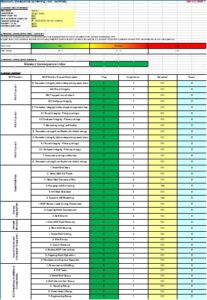
Picture from the Toll developed in the project
Highlights:
The focus of this project was to develop a standardized methodology for analyzing the consequences of offshore well blowouts to improve risk measurement and mitigation in the oil and gas industry. By addressing existing gaps in current blowout contingency planning practices, the project sought to create a structured framework that operators can use to better prepare for and respond to potential blowout scenarios. Key areas of study included relief well feasibility, subsea capping strategies, oil spill response, and the development of a Blowout Preparedness Screening Tool (BPST).
OESI funding played a critical role in enabling this work by supporting the collaboration of subject matter experts, facilitating comprehensive research, and ensuring the delivery of a robust set of tools and guidelines. This support helped ensure the integration of best practices, historical data, and simulation capabilities into a practical, risk-based decision-making tool.
What makes this project impactful and unique is its exclusive focus on the consequence side of blowout events—an area often underrepresented in well planning. By offering a standardized, scalable solution for blowout consequence assessment, the project empowers operators to enhance their preparedness and reduce the environmental, financial, and reputational impacts of offshore well control incidents.
Acknowledgements:
The project team would like to acknowledge our partner WellCRTL Engineering, Houston, Texas for contributing to this project.
HeonYong Kang – Texas A&M Engineering Experiment Station

Highlights:
The offshore oil and gas sector is urgently seeking local power solutions for marginal fields, where umbilicals—the most widely used power supply method—are not economically viable. Wave Energy Converters (WECs) present a competitive alternative for serving as remote power stations. As a renewable energy source, WECs produce zero carbon emissions. Through this project, we developed 81 use cases where kW-scale WECs can support offshore oil and gas operations, providing local power and transferring data onshore. Each use case includes power requirement and is associated with at least one and up to six OEMs. Additionally, use cases are categorized by operation prevalence and lifecycle stages of the oil gas fields. For the offshore sector, this allows leaseholders to readily select desirable use cases based on their fields’ current lifecycles and assess uncertainty based on operation prevalence. With power requirements and OEMs specified, system operators/providers can identify applicable use cases and integrate renewable energy into their systems. For the WEC sector, companies can co-develop new products with OEMs or contact leaseholders directly to power their existing subsea assets. This project bridges the needs of both sectors—introducing a kW-scale remote power solution to offshore oil gas sector and uncovering new commercial deployment opportunities for WEC sector, offering a fresh perspective on how WECs can be integrated into offshore oil and gas operations.
Acknowledgements:
The project team would like to acknowledge Oceaneering for providing valuable insights into autonomous underwater vehicles.
Yuanhang Chen – Louisiana State University

Highlights:
The project developed and field‑tested an integrated framework that unifies three state‑of‑the‑art real‑time gas kick detection and profiling methods—physics‑based data assimilation (DA) for continuous influx estimation, distributed fiber‑optic sensing (DFOS) for high‑resolution wellbore monitoring, and a Bayesian network with change‑point analysis (CP‑BN) for early anomaly recognition—into a single decision‑support platform. This multi‑method system was rigorously validated at LSU’s PERTT Lab full‑scale well facility and using state-of-art drilling simulator platform, achieving false‑alarm rates below 3%, detection times under 30 seconds across diverse drilling scenarios .
OESI funding was instrumental in bringing together academic researchers and industry partners—Blade Energy Partners and Intellicess—while underwriting access to advanced testbeds, specialized fiber‑optic sensor arrays, and high‑fidelity simulation environments. This support also enabled targeted workshops and surveys that refined an updated Offshore Loss of Well Control (LOWC) leading‑indicator set, tailored for contemporary offshore operations.
By unifying complementary technologies into a cohesive solution, our platform offers a first‑of‑its‑kind, holistic approach to well‑control risk management implemented with a new LOWC leading indicator system. Controlled simulations confirmed their resilience across diverse scenarios—from deepwater high‑pressure risers to complex formation integrity tests—and its modular design means future measurement innovations can be plugged in seamlessly. With faster insights and fewer false alarms, operators can safeguard people, protect the environment, and keep offshore energy flowing safely into the future.
Acknowledgements:
The project team gratefully acknowledges the contributions and valuable feedback provided by Pedro Sousa and Alexa Gonzalez Luis from Blade Energy Partners, Ltd., as well as the contributions from all industry panel discussion participants. In addition, we also thank and acknowledge all collaborators at Louisiana State University who participated/supported this project: Otto Santos, Mauricio A. Almeida, Mahendra Kunju, and Douglas Hoy.
Kevin McSweeney – American Bureau of Shipping
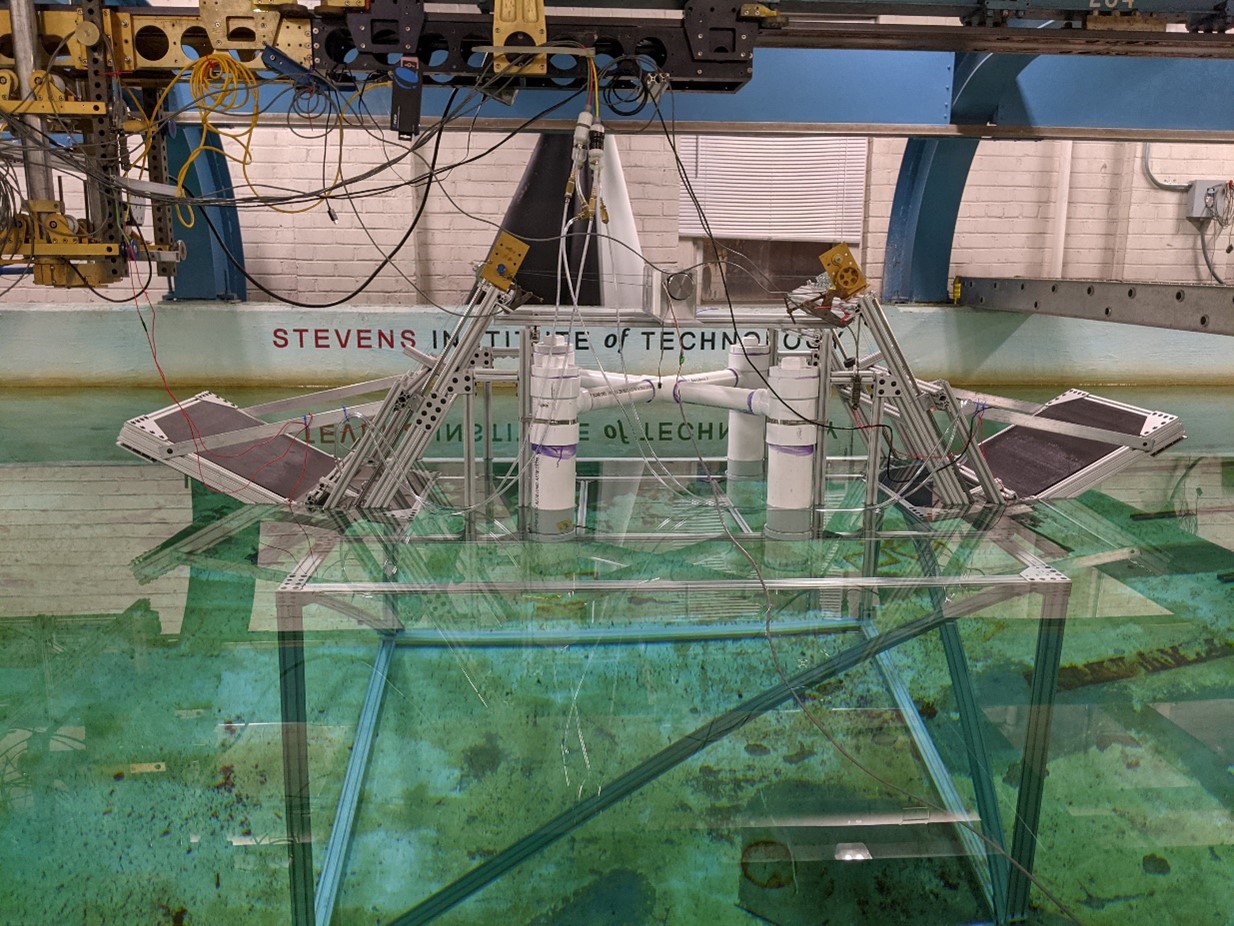
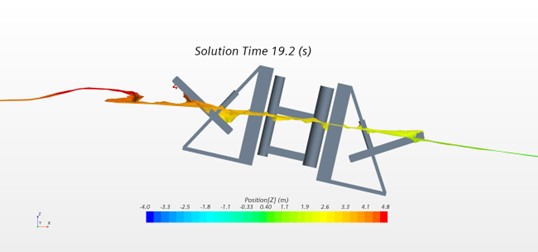
Highlights:
Acknowledgements:
ABS: Kevin McSweeney, Whitney Mantooth, Suqin Wang, Lauren Sparks
E-Wave Technologies: Jason Lou
University of Michigan: Paul Green
Hydrokinetic Energy Corp.: Walter Schurtenberger
Bluewater Network LLC: Bill Staby

